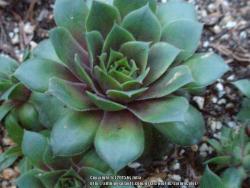Given the characteristic of color changes and the fact that the plants look slightly different when exposed to different environmental factors, it would be very easy to mix up the cultivar names of these chameleon plants. This was a problem: Cultivars were not consistent for the major growers of sempervivums.
Mr. and Mrs. Bruce Crane had a fancy for these plants and began the Dalton Project at their nursery, Sugar Hill, in Dalton, MA. With 400 known cultivars on the market, this was going to take some time. It began in 1970, with invitations going out to three of the major sempervivum nurseries in the United States. The invitation was a request to contribute a sample of the named sempervivums to Sugar Hill Nursery for evaluation. At the end of the evaluation, each nursery would then receive correctly named cultivars, making the cultivars consistent thoughout the United States.
The control group for this study would have to come from the United Kingdom, as this was the only location that had an authority on sempervivums. Peter Mitchell therefore sent 300 cultivars to Dalton, MA, for the study. Sadly, many of the English control plants arrived small or dead, so more had to be sent. Sempervivums take time to show their true characteristics, and the process would take four years before any conclusions could be reached.
As the plants arrived at Dalton, the cultivars were to be grown side by side. Each cultivar was potted up into a 6"x 4" pot with sterile potting soil and was labeled. The sempervivums were evaluated twice a year, in spring and in fall. In 1974 the project was completed. Of the 332 plants in the original group, 128 were dubious. It was impossible to determine their true identity, and they were destroyed. The other 204 cultivars were clearly identifiable, and clones of these plants were sent to the participating nurseries.
The next issue would entail keeping the named cultivars straight, so the Sempervivum Fanciers Association Newsletter was created. Many of the great hybridizers belonged to this group of fanciers, and as a group they encouraged high-quality hybrids and eliminated look-alike cultivars. Sadly, this newsletter is no longer in production, and there is no way to control the sempervivum names in the United States.
Example



'Cranberry,' 'Pacific Sexy,' and 'Jade Sleeper'
These three sempervivums look similar and easily could be confused for one another. These pictures were taken in my garden about a week ago.
| Thread Title | Last Reply | Replies |
|---|---|---|
| Great article by Oberon46 | Sep 11, 2015 9:11 AM | 8 |